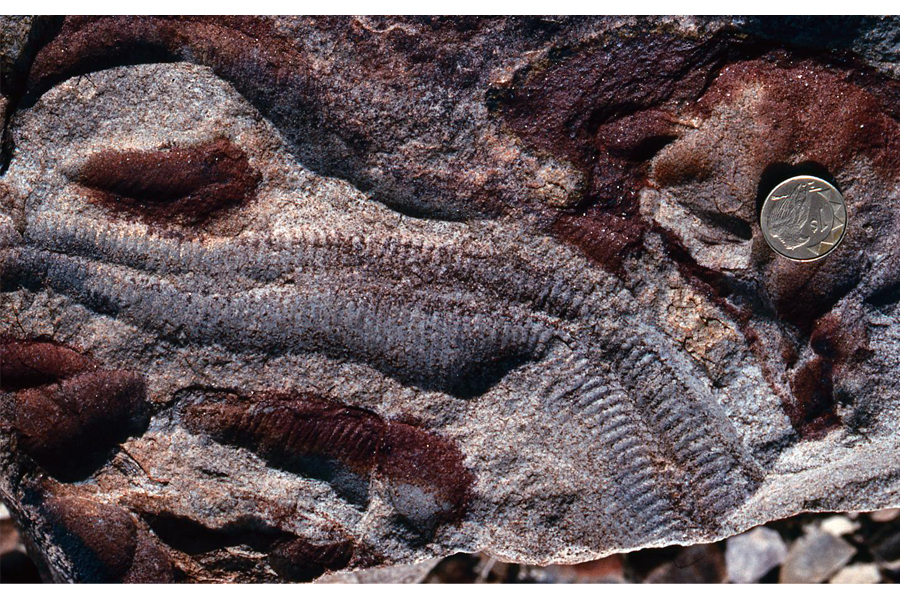How oxygen may have jumpstarted the rise of animals
Loading...
Life likely didn't arise on Earth and then immediately evolve into the complex organisms we call animals. Instead, the fossil record suggests that simpler organisms ruled the Earth for billions of years before animals started to take over around 600 million years ago. But why did it happen that way?
Scientists have long puzzled over what changed, or what was lacking, in the early Earth's environment to cause such staggered evolution. Some scientists proposed that an increase in atmospheric oxygen helped kickstart animal evolution, but the story might not be that simple.
In sorting out whether a change in oxygen could have triggered animal evolution, scientists are trying to figure out what exact oxygen levels and distribution might have been hundreds of millions of years ago.
One complexity of the model is that the life that did exist in the middle Proterozoic was in the world's oceans, so scientists wanted to pin down how a change in atmospheric oxygen levels would affect concentration in ocean waters. And a new study published Monday in the journal Proceedings of the National Academy of Sciences takes a swing at just that challenge.
Christopher Reinhard, a biogeochemist at Georgia Institute of Technology in Atlanta, and his team ran simulations to see how oxygen would be distributed in the ocean at different atmospheric oxygen levels in a computer model. They also simulated how oxygen levels change in different parts of the ocean over time.
And it turns out, in the time leading up to the emergence of animals, from about 1.8 billion to 600 million years ago, "the oxygen distribution in the oceans would have been really patchy," Dr. Reinhard tells The Christian Science Monitor, as some areas are deeper, some warmer, some with different currents, and other factors influencing the composition of the waters.
Furthermore, Reinhard and his team found that the pockets of higher concentrations of oxygen would probably have oscillated or grown and shrank seasonally. "So for part of the year they would be great places for animals to live, but for part of the year they would have been really inhospitable," he says.
And these results suggest that it wasn't such a simple story of increasing the supply of oxygen available to organisms living on early Earth, Daniel Mills, a postdoc in the Nordic Center for Earth Evolution (NordCEE) at the University of Southern Denmark who was not part of the study, tells the Monitor.
"They do a good job of showing that you can't just look at some fixed oxygen threshold, or some fixed concentration of oxygen in the atmosphere," Dr. Mills says. "In reality, it's much more complex and our thinking on this has to be a little more nuanced."
Mills says this computer model is "a good foundation" and "a valuable reference" for further research, but that this framework is not the decisive, end-all-be-all model of what was behind the emergence of animal life.
Reinhard says the model provides predictions for where early animal life could have been distributed across the globe, and this gives paleontologists an idea where to look in the fossil record for more clues. "I think the next step will be linking it explicitly to the fossil record," he says of his team's model. And, he adds, seeing how the model meshes with the fossil record will help refine these models.
Mills says it's also important to look at organisms alive today. "Using this model, you can go to environments that you think could have been more representative of the early Earth, you can look at the ecology, the food chains there, the organisms that live there, how they make a living, their energy metabolism, their relationship to other organisms, those sorts of things," he says. "And then you can say maybe the early Earth exhibited these sorts of ecological interactions," diversity of life, similar conditions, etcetera.
For example, Mills says, the Cariaco basin off the coast of Venezuela might be a good place to start. The basin is a low-oxygen system, despite atmospheric oxygen levels being much higher than scientists think they were in the Protozoic. Similar to Reinhard's model, the basin displays patchy, oscillating oxygen levels.
And, Mills points out, modern low-oxygen systems like the Cariaco basin "are not devoid of eukaryotes." Instead, he says, there are diverse organisms adapted to the low-oxygen environments.
There's still a chance that changing oxygen levels might not be the one and only trigger for animal evolution, Mills says.
"There's so many different environmental parameters to consider, outside of oxygen," he says. "Other ones are temperature, or the salinity of the ocean, for example. These are other things that people have talked about with respect to an environmental constraint that held back early animals."
Sorting out the conditions from which complex eukaryotes (a.k.a. animals) arose on Earth isn't just about understanding our own history. Understanding the evolution of life on Earth could help scientists figure out how to identify fingerprints of life on other planets.
"I think this pretty simple question of whether or not it's linked to the oxygen cycle is an enormously important one," Reinhard says. As scientists analyze the chemical composition of exoplanets' atmospheres, they'll be looking for clues that the planet could host complex life. If they know that high levels of atmospheric oxygen was crucial in the evolution of life on Earth, they could pose the same question of an alien planet: Are high levels of oxygen and the rise of complex life intimately linked?
"I think understanding the way that this worked out on Earth is really our first step towards making that a question that you can actually pose scientifically instead of just sort of musing about it at a dinner party," he says.








